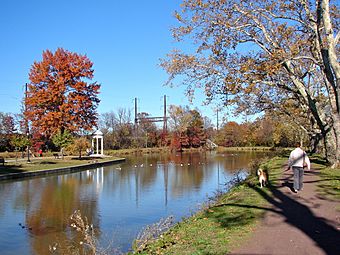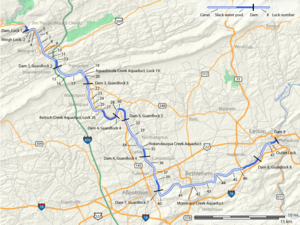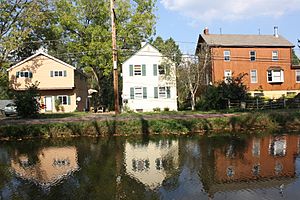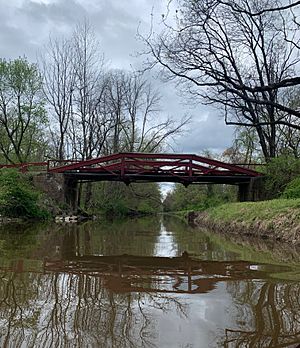Pennsylvania Canal (Delaware Division) facts for kids
|
Delaware Division of the Pennsylvania Canal System
Delaware Division of Lehigh Navigation Coal Company |
|

Delaware Canal State Park in Bristol
|
|
| Location | Bristol–60 miles (97 km)–Easton & connections from the Lehigh Canal and Morris Canal. |
|---|---|
| Built | 1828-1831, 1832-34 |
| MPS | Covered Bridges of the Delaware River Watershed TR (AD) |
| NRHP reference No. | 74001756 |
Quick facts for kids Significant dates |
|
| Added to NRHP | October 29, 1974 |
| Designated NHLD | December 8, 1976 |
The Delaware Canal is a historic waterway in Pennsylvania. It stretches for about 60 miles (97 km) (97 km) along the Delaware River. The canal starts near Easton and goes south to Bristol.
This canal was a very important part of Pennsylvania's transportation system. It helped move goods across the state. At Easton, the Delaware Canal connected with the Lehigh Canal and the Morris Canal. These connections allowed coal and other materials to travel to places like New Jersey and even New York City.
The main purpose of the Delaware Canal was to carry anthracite coal. This type of coal was the most important fuel source back then. The canal also moved other heavy goods like gravel, limestone, cement, and lumber. In return, it carried manufactured goods and iron products back to the northeastern cities.
The Delaware Canal first opened in 1832. It still has many of its original parts, like locks and aqueducts. Even though railroads later took over much of the coal transport, the canal kept working until the 1930s. It is known as the "longest-lived canal in the country."

Contents
History of the Delaware Canal
Building a Waterway for Trade
The idea for the Pennsylvania Canal system came from the success of the Erie Canal in New York State. The Erie Canal opened in 1825 and showed how useful canals could be.
Construction on the Delaware Canal began in 1829. It was a huge project done mostly by hand. Many workers from Ireland helped build it. The canal was dug to run next to the Delaware River. You can often see the river from the canal path.
Originally, the canal was about 60 miles (96.6 km) long. It was about 60 feet (18.3 m) wide and 3 feet (0.9 m) deep.
Challenges and Changes
The first construction of the canal didn't work well in 1830. So, a man named Josiah White helped redesign it. He was from the Lehigh Coal and Navigation Company. Later, in 1858, the state sold the canal to his company.
The Delaware Canal made it easier to move coal from places like Mauch Chunk and Wilkes-Barre. Millions of tons of coal traveled down the Lehigh Valley and then finished their journey on barges in the Delaware Canal.
Decline and Preservation Efforts
Over time, railroads became more popular. They could move goods faster than canals. This led to less barge traffic on the canal. By the 1920s, anthracite coal was also used less as a fuel. The last commercial boats used the canal in 1931. The company that owned it went bankrupt and sold the canal back to the state.
In 1933, a group called The Delaware Valley Protective Association (DVPA) formed. They wanted to save the canal because it was an important historical site. They convinced the state to start taking care of the canal again in 1940. The path next to the canal, called the towpath, became Theodore Roosevelt State Park. The canal was repaired and refilled with water.
In the 1960s, some officials thought about paving over the canal to make a road. But local people fought to protect it. In 1964, a historian named Willis M. Rivinus wrote a guide to the canal. This book helped show how valuable the canal was.
Through the 1960s and 1970s, people worked to get federal protection for the canal. In 1974, it was added to the National Register of Historic Places. In 1976, it was named a National Historic Landmark. These steps helped make sure the canal would be preserved. The towpath also became an official National Recreation Trail.
In 1988, the U.S. government created the Delaware and Lehigh National Heritage Corridor. This area includes the Delaware Canal. In 1989, Theodore Roosevelt State Park was renamed Delaware Canal State Park.
Today, a group called the Friends of the Delaware Canal (FODC) helps care for the canal. They raise money and organize volunteers. They work to keep the towpath walkable and the canal filled with water from Easton to Bristol.
Recent Challenges
The canal has faced challenges, including floods. Floods in 2004, 2005, and 2006 damaged parts of the towpath. In 2008, a section of the towpath collapsed, causing 23 miles (37 km) of the canal to lose water.
The Federal Emergency Management Agency and the Pennsylvania Department of Conservation and Natural Resources (PA DCNR) have been working to fix the damaged parts. By 2009, much of the towpath was restored.
How the Canal Works: Engineering
At New Hope, engineers found a clever way to fill the canal with water. They used a special water wheel that was turned by the river's current. This wheel then powered another wheel with buckets. These buckets lifted water from the Delaware River up into the canal.
There was also a lock that connected the canal to the Delaware River. On the other side of the river, there was a lock to the Delaware and Raritan Canal. To help boats cross the river, engineers used a system of cables. Two cables of different lengths were attached to a main cable stretched across the river. This setup held a boat at an angle to the current, making the current push the boat across like a sail.
Mule Barge Tourist Rides
For many years, visitors could enjoy rides on mule-drawn barges. These rides started at Lock #11 in New Hope. The barges traveled north for about 4.5 miles (7.2 km).

Tourist rides were offered from about 1954 to 2006. Each boat could carry between 55 and 80 passengers. Two mules pulled each boat. There were four boats originally: the Americana, the Independence, the Liberty, and the Spirit of New Hope. In 1997, they were replaced by two new boats, the Molly Pitcher and the Myfanwy Jenkins.

.
These barge operations had to follow rules from the U.S. Coast Guard. For example, the steersmen (the people steering the boat) needed a special license. If the rides reopen, they would also need to follow rules from the U.S. Department of Homeland Security.




